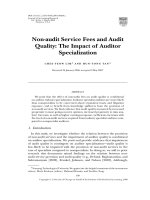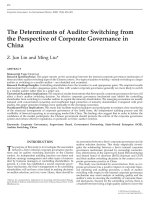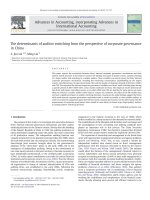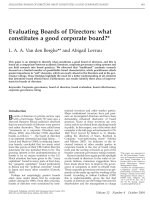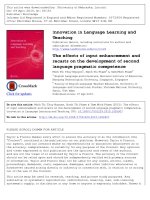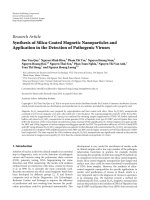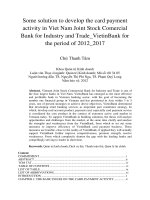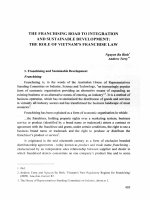Lin, tan seven controlled vocabularies and obituaries 2004 the joy of cooking
Bạn đang xem bản rút gọn của tài liệu. Xem và tải ngay bản đầy đủ của tài liệu tại đây (3.64 MB, 223 trang )
[inside back cover]
SEVEN CONTROLLED VOCABULARIES
2004
[AIRPORT NOVEL MUSICAL POEM PAINTING THEORY FILM PHOTO LANDSCAPE]
: TAN LIN
FOREWORD
LAURA RIDING
JACKSON
LIMITED AVAILABILITY:
YALE YOUNGER
WAL-MART
ASCII
PSA
S
Library of Congress Cataloging-in-Publication Data
Lin, Tan, 1957Seven controlled vocabularies and obituary 2004, the joy of cooking :
airport novel musical poem painting film photo hallucination landscape /
Tan Lin.
p. cm. — (Wesleyan poetry)
isbn 978-0-8195-6928-8 (cloth : alk. paper) — isbn 978-0-8195-6929-5 (pbk. :
alk. paper)
I. Title.
PS3612.I516S48 2009
811'.6—dc22
2009018192
Published by Wesleyan University Press
Middletown, CT 06459
Copyright 2010 by Tan Lin
printed in the united states of america
5
4
3
2
1
Wesleyan University Press is a member of the Green Press Initiative. the
paper used in this book meets their minimum requirement for recycled paper.
this project is supported in part
by an award from the
national endowment for the arts.
FOR/TO
11/07
2.21
SEVEN CONTROLLED VOCABULARIES
2004
THE JOY OF COOKING
[AIRPORT NOVEL MUSICAL POEM PAINTING FILM PHOTO LANDSCAPE]
: TAN LIN
WESLEYAN UNIVERSITY PRESS
middletown, connecticut
AND OBITUARY
FOREWORD
LAURA RIDING JACKSON
This page intentionally left blank
ACKNOWLEDGEMENTS
I wrote this book while I was a Post-doctoral Research Fellow at Liverpool John
Moores University between 1999 and 2002, and I am very grateful to the Department
of Literature and Cultural History, especially Pam Morris, for my appointment, without
which the work would not have been possible. I would like to thank the following
people for talking to me about the ideas and for reading drafts of the material: Matt
Jordan, William Outhwaite, Charlotte Raven, Judith Williamson. I’d also like to thank
Verso, and especially my editor Jane Hindle, for publishing the book. My family has
been immensely supportive as always.
The illustrations on the following pages appear by courtesy of the copyright holders:
p. 45: Stanley Spencer, The Resurrection, Cookham (1924 – 27). © Tate, London 2001.
p. 237: Hieronymus Wierix, Christ in the Wine Press (c. 1600). © Copyright The British
Museum. p. 256: The Guardian newspaper front cover (G2 supplement), 9 July 2001.
Artwork by Daniel Hansen. Thanks to The Organisation and the Guardian.
The photograph on p. 182 is by the author.
9
EDITORIAL NOTE
My collaborative aim in the production of this work has been to offer a series of intratextual corrections in a typescript produced and renovated over several decades by
more than one author. There are numerous errors of omission because blandness
has no boundaries. Plagiarism is another manner. It was one of the necessary aims
of revision.
Much of the work involved considerably less labor, was less meaningful in its aims,
being merely a mechanical transcription of a clear text, but in other places more
idiosyncratic handwritten notations or stylistic devices, or even choices of words have
made the production more difficult and less literary than it need to have been. Such
work is of the past of course. Such reading is of the present.
There is nothing that can come between between indifference and a form of redundancy. Except perhaps an omission. Multiple authorial redundancies could not be
avoided. These lapses were welcomed wherever they might have been found in the
text. Accordingly, there is nothing spectral, bracketed [
] or metaphysical
that remains, which is merely the husk of things that were true at the moment when
they were once, [hallucinated] and by once I mean once written down without hope
for any future, imagined or otherwise intended. There is truth and there is truth.
New York, 2004
10
This page intentionally left blank
A Field Guide to American Painting
ES
13 plates
This page intentionally left blank
first plate
Laura Riding, Anarchism Is Not Enough
15
5:27
35°
What are the forms of non-reading and what are the non-forms a reading might take?
Poetry = wallpaper. Novel = design object. Text as ambient soundtrack? Dew-champ
wanted to create works of art that were non-retinal. It would be nice to create works
of literature that didn’t have to be read but could be looked at, like placemats. The
most exasperating thing at a poetry reading is always the sound of a poet reading.
16
plate 1
17
FW HW 1¼" – 1"
What [
] you are seeing is executed in Director and plays independently of any
intuited reading [voice] practices. It takes place in real time, and like a feedback loop
it is different each time it is played. The work was executed in b/w because b/w is
more soothing than color. Halfway through the program, a color randomizer has been
inserted to provide a greater sense of visual permutation, change and pleasure. One
word, then another, and finally a third follow each other in a kind of slow-motion,
time-lapse photography.
[S]
18
plate 2
19
SIDE B
Poems to be looked at vs. poems to be read vs. paintings to be sequenced vs. paintings to be sampled. Everything that is beautiful is a code for something that is already
known. Nothing should be unknown. The program [
] code you are watching
generates 16.7 million different shades of color backgrounds. Some of these are suggestive. None of them functions in place of memory. Memory cannot be sequenced.
Memory is usually non-designed. You are about to enter: ] Three rooms. Mirror balls.
Roving wallpaper. Disco. Home Furnishings. Lifestyle. Getting up [
] and having
a drink.
20
plate 3
21
C
Of course, in some novelistic vein, sequencing is highly absorptive, and so at the
subliminal, i.e., non-designed level, the sequencing allows reading itself to become
abstract, [bracketed] hypnotic, and [mesmerizing.] The problem with most poetry,
like most design and architecture, is that it is a little too bourgeois. For this reason,
the poem [or novel] should never be turned off. It is unfortunate but everyone says
“cogito” in the Franco-American novel. Like a thermostat, it should regulate the
room’s energies. This allows the piece to constantly erase itself. As we all know,
poetry and the novel should aspire not to the condition of music but to the condition of relaxation and yoga. A lot of people think great poems should be memorized.
As anyone who has ever read a painting will tell you [like Ed Ruscha], paintings, like
poems, are most beautiful [and least egotistical] at the exact moment in which
they are forgotten, like disco and other Four on the Floor Productions.
22
plate 4
23
110
Each sequence or sentence, i.e., word set, runs 7.2 seconds or the amount of time
it takes to pronounce each word, one word at a time. 7 is generally thought to be
the number of things the human brain can readily remember. George Miller did
pioneering studies on this and his theory is called Miller’s Number Seven. Hence,
most phone numbers are seven digits in length. 7.2 seconds is hopefully just long
enough to get the reader/viewer into a groove. It might suggest a strobe light going
off at timed intervals. The interval can be beautiful because the interval can be
dubbed. Relaxation like non-designed home décor, has no real bounds. It supplements that thing known as real life. That is why it is so pleasurable to read.
Someone (I think) said the time for poems written with words and the era of reading
poems with feelings in them is long gone. Today, no poem should be written to be
read and the best form of poetry would make all our feelings disappear the moment
we were having them. This sequencing of “events” constitutes a code more uncrackable and soothing than anything we could actually see. “Paintings to be read”
“poems to be looked at.” A beautiful poem should rewrite itself one half-word at a
time, in predetermined intervals. With their numerous circuit boards, televisions
and computers do this; together, they enhance the microproduction and sequencing
of feelings heretofore thought inaccessible, complex, or purely entropic. If all paintings could just be codes projected onto a wall, those names (accessories) for things
canceling the wall would be more beautiful than anything we could feel.
24

![brown and calor - 2004 - the correlation between corporate governance and company performance [cgs-fp]](https://media.store123doc.com/images/document/2015_01/02/medium_izzlTXr0MM.jpg)
